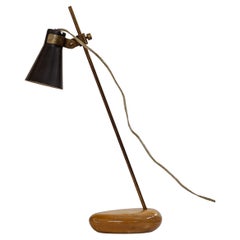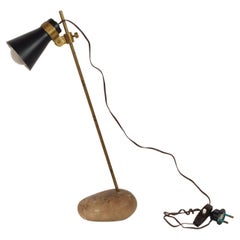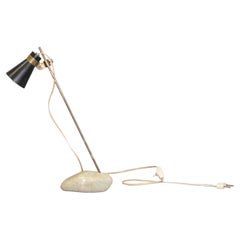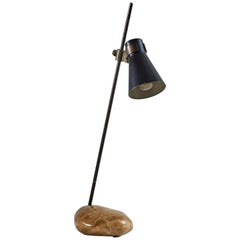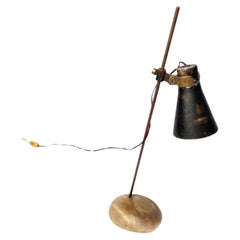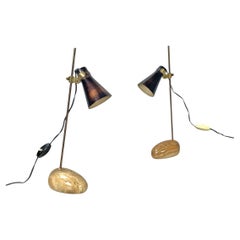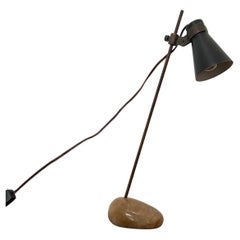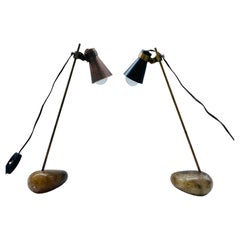Caccia Dominioni Sasso
Vintage 1950s Italian Mid-Century Modern Table Lamps
Stone, Brass, Metal
Vintage 1940s Italian Mid-Century Modern Table Lamps
Stone, Aluminum, Brass
Mid-20th Century Italian Mid-Century Modern Table Lamps
Brass
Vintage 1940s Italian Mid-Century Modern Table Lamps
Onyx, Aluminum
20th Century Italian Mid-Century Modern Table Lamps
Stone, Brass, Aluminum
Vintage 1950s Italian Mid-Century Modern Table Lamps
Onyx, Brass
Recent Sales
Vintage 1950s Post-War Desk Accessories
Vintage 1950s Italian Mid-Century Modern Table Lamps
Stone, Metal, Brass, Enamel
Mid-20th Century Italian Mid-Century Modern Table Lamps
Onyx, Aluminum, Brass
Vintage 1950s Italian Mid-Century Modern Table Lamps
Stone, Brass, Iron
Mid-20th Century Italian Mid-Century Modern Table Lamps
Brass
Mid-20th Century Italian Mid-Century Modern Table Lamps
Brass
People Also Browsed
20th Century Italian Modern Dining Room Tables
Oak
2010s South African Minimalist Pedestals
Hardwood
2010s Dutch Modern Side Tables
Travertine
2010s British Scandinavian Modern Ottomans and Poufs
Velvet, Mohair, Oak
21st Century and Contemporary Portuguese Modern Side Tables
Chestnut
21st Century and Contemporary Swedish Mid-Century Modern Table Lamps
Textile
2010s South African Minimalist Night Stands
Wood
Vintage 1930s Italian Art Deco Armchairs
Beech
Vintage 1970s Italian Post-Modern Beds and Bed Frames
Steel, Chrome
21st Century and Contemporary French Brutalist Night Stands
Oak
21st Century and Contemporary English Folk Art Side Tables
Iron
21st Century and Contemporary French Mid-Century Modern Chandeliers and ...
Brass
Vintage 1960s Italian Mid-Century Modern Wall Lights and Sconces
Brass, Nickel
Vintage 1960s Italian Mid-Century Modern Flush Mount
Brass, Nickel
Vintage 1940s French Mid-Century Modern Flush Mount
Brass
2010s Italian Modern Chandeliers and Pendants
Brass
Luigi Caccia Dominioni for sale on 1stDibs
To join the centenarian club is a remarkable feat in itself, but to live for over a century and leave a lasting impact on the world of Italian mid-century modern furniture design — just as pioneering industrial designer and architect Luigi Caccia Dominioni had — is extraordinary. His vintage table lamps, coffee tables, chairs and other furnishings are demonstrative of exemplary technique, theory and quality workmanship — all characteristics of the Milanese designer’s signature style.
Caccia Dominioni graduated from Milan’s oldest university, the Polytechnic University of Milan, in 1936. A leading center for design innovation during the first half of the 20th century, the institution’s alumni includes notable Italian architects and designers such as Gio Ponti, Vittoriano Vigano and brothers Livio and Pier Giacomo Castiglioni. In 1937, the Castiglioni brothers and Caccia Dominioni opened a multi-award winning studio together and presented groundbreaking designs for radios in Bakelite shells at the 1940 Milan Triennial.
The Second World War forced Caccia Dominioni to pause his professional ambitions in order to serve in the Italian military, and the postwar years saw much of his most esteemed designs take shape. In 1947, alongside Ignazio Gardella and Corrado Corradi Dell’Acqua, Caccia Dominioni founded the furniture manufacturing company Azucena, where he designed iconic pieces such as the Catalina chair and a range of lighting that includes the Lp10 wall light, the Lsp3 wall light and the Lsp6 flush mount light.
Like a fine Italian wine, Caccia Dominioni got even better with time. He collaborated with the likes of Olivari and Lualdi well into his 80s, debuting legendary pieces such as the C.d.o. chair and the Super door. And while many of his celebrated architectural works materialized during the 1950s and 1960s — such as the Teatro Filodrammatici and the Galleria Strasburgo — one of Caccia Dominioni’s best known structures, the fountain in Milan’s Piazza San Babila, was built near the end of 20th century when the designer was 83 years old.
Caccia Dominioni was a winner of the Compasso d’Oro, one of the oldest and most prestigious awards in the design industry. When he died at 103 in 2016, he left behind an exceptional legacy of furniture design and architectural innovations.
Find vintage Luigi Caccia Dominioni chandeliers and pendants, floor lamps, armchairs and other furniture on 1stDibs.
A Close Look at Mid-century-modern Furniture
Organically shaped, clean-lined and elegantly simple are three terms that well describe vintage mid-century modern furniture. The style, which emerged primarily in the years following World War II, is characterized by pieces that were conceived and made in an energetic, optimistic spirit by creators who believed that good design was an essential part of good living.
ORIGINS OF MID-CENTURY MODERN FURNITURE DESIGN
- Emerged during the mid-20th century
- Informed by European modernism, Bauhaus, International style, Scandinavian modernism and Frank Lloyd Wright’s architecture
- A heyday of innovation in postwar America
- Experimentation with new ideas, new materials and new forms flourished in Scandinavia, Italy, the former Czechoslovakia and elsewhere in Europe
CHARACTERISTICS OF MID-CENTURY MODERN FURNITURE DESIGN
- Simplicity, organic forms, clean lines
- A blend of neutral and bold Pop art colors
- Use of natural and man-made materials — alluring woods such as teak, rosewood and oak; steel, fiberglass and molded plywood
- Light-filled spaces with colorful upholstery
- Glass walls and an emphasis on the outdoors
- Promotion of functionality
MID-CENTURY MODERN FURNITURE DESIGNERS TO KNOW
- Charles and Ray Eames
- Eero Saarinen
- Milo Baughman
- Florence Knoll
- Harry Bertoia
- Isamu Noguchi
- George Nelson
- Danish modernists Hans Wegner and Arne Jacobsen, whose emphasis on natural materials and craftsmanship influenced American designers and vice versa
ICONIC MID-CENTURY MODERN FURNITURE DESIGNS
- Eames lounge chair
- Nelson daybed
- Florence Knoll sofa
- Egg chair
- Womb chair
- Noguchi coffee table
- Barcelona chair
VINTAGE MID-CENTURY MODERN FURNITURE ON 1STDIBS
The mid-century modern era saw leagues of postwar American architects and designers animated by new ideas and new technology. The lean, functionalist International-style architecture of Le Corbusier and Bauhaus eminences Ludwig Mies van der Rohe and Walter Gropius had been promoted in the United States during the 1930s by Philip Johnson and others. New building techniques, such as “post-and-beam” construction, allowed the International-style schemes to be realized on a small scale in open-plan houses with long walls of glass.
Materials developed for wartime use became available for domestic goods and were incorporated into mid-century modern furniture designs. Charles and Ray Eames and Eero Saarinen, who had experimented extensively with molded plywood, eagerly embraced fiberglass for pieces such as the La Chaise and the Womb chair, respectively.
Architect, writer and designer George Nelson created with his team shades for the Bubble lamp using a new translucent polymer skin and, as design director at Herman Miller, recruited the Eameses, Alexander Girard and others for projects at the legendary Michigan furniture manufacturer.
Harry Bertoia and Isamu Noguchi devised chairs and tables built of wire mesh and wire struts. Materials were repurposed too: The Danish-born designer Jens Risom created a line of chairs using surplus parachute straps for webbed seats and backrests.
The Risom lounge chair was among the first pieces of furniture commissioned and produced by celebrated manufacturer Knoll, a chief influencer in the rise of modern design in the United States, thanks to the work of Florence Knoll, the pioneering architect and designer who made the firm a leader in its field. The seating that Knoll created for office spaces — as well as pieces designed by Florence initially for commercial clients — soon became desirable for the home.
As the demand for casual, uncluttered furnishings grew, more mid-century furniture designers caught the spirit.
Classically oriented creators such as Edward Wormley, house designer for Dunbar Inc., offered such pieces as the sinuous Listen to Me chaise; the British expatriate T.H. Robsjohn-Gibbings switched gears, creating items such as the tiered, biomorphic Mesa table. There were Young Turks such as Paul McCobb, who designed holistic groups of sleek, blond wood furniture, and Milo Baughman, who espoused a West Coast aesthetic in minimalist teak dining tables and lushly upholstered chairs and sofas with angular steel frames.
Generations turn over, and mid-century modern remains arguably the most popular style going. As the collection of vintage mid-century modern chairs, dressers, coffee tables and other furniture for the living room, dining room, bedroom and elsewhere on 1stDibs demonstrates, this period saw one of the most delightful and dramatic flowerings of creativity in design history.
Finding the Right Table-lamps for You
Well-crafted antique and vintage table lamps do more than provide light; the right fixture-and-table combination can add a focal point or creative element to any interior.
Proper table lamps have long been used for lighting our most intimate spaces. Perfect for lighting your nightstand or reading nook, table lamps play an integral role in styling an inviting room. In the years before electricity, lamps used oil. Today, a rewired 19th-century vintage lamp can still provide a touch of elegance for a study.
After industrial milestones such as mass production took hold in the Victorian era, various design movements sought to bring craftsmanship and innovation back to this indispensable household item. Lighting designers affiliated with Art Deco, which originated in the glamorous roaring ’20s, sought to celebrate modern life by fusing modern metals with dark woods and dazzling colors in the fixtures of the era. The geometric shapes and gilded details of vintage Art Deco table lamps provide an air of luxury and sophistication that never goes out of style.
After launching in 1934, Anglepoise lamps soon became a favorite among modernist architects and designers, who interpreted the fixture as “a machine for lighting,” just as Le Corbusier had reimagined the house as “a machine for living in.” The popular task light owed to a collaboration between a vehicle-suspension engineer by the name of George Carwardine and a West Midlands springs manufacturer, Herbert Terry & Sons.
Some mid-century modern table lamps, particularly those created by the likes of Joe Colombo and the legendary lighting artisans at Fontana Arte, bear all the provocative hallmarks associated with Space Age design. Sculptural and versatile, the Louis Poulsen table lamps of that period were revolutionary for their time and still seem innovative today.
If you are looking for something more contemporary, industrial table lamps are demonstrative of a newly chic style that isn’t afraid to pay homage to the past. They look particularly at home in any rustic loft space amid exposed brick and steel beams.
Before you buy a desk lamp or table lamp for your living room, consider your lighting needs. The Snoopy lamp, designed in 1967, or any other “banker’s lamp” (shorthand for the Emeralite desk lamps patented by H.G. McFaddin and Company), provides light at a downward angle that is perfect for writing, while the Fontana table lamp and the beloved Grasshopper lamp by Greta Magnusson-Grossman each yield a soft and even glow. Some table lamps require lampshades to be bought separately.
Whether it’s a classic antique Tiffany table lamp, a Murano glass table lamp or even a bold avant-garde fixture custom-made by a contemporary design firm, the right table lamp can completely transform a room. Find the right one for you on 1stDibs.
